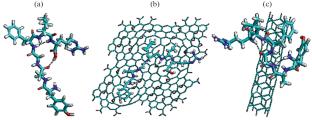在无溶剂有机化合物中引入氢同位素的各种材料的使用
IF 0.3
Q4 MATERIALS SCIENCE, MULTIDISCIPLINARY
引用次数: 0
摘要
摘要:介绍了不使用溶剂将氢同位素引入有机化合物的方法。给出了用于制备反应混合物的无机载体,包括纳米材料。将氘或氚标签引入有机化合物(包括不饱和化合物和耐热化合物)的固相方法的可能性。考虑了反应条件对标记物的产率和氢同位素包合度的影响。试图通过系统中发生的过程来解释所获得的数据氢同位素-催化剂-载体-化合物的性质。本文章由计算机程序翻译,如有差异,请以英文原文为准。

The Use of Various Materials in the Introduction of Hydrogen Isotopes into Organic Compounds without Solvents
Abstract—Methods of introducing hydrogen isotopes into organic compounds without the use of solvents are described. Inorganic carriers, including nanomaterials, that are used to prepare reaction mixtures are given. The possibilities of a solid-phase method for introducing a deuterium or tritium label into organic compounds, including unsaturated and thermolabile compounds are shown. The influence of reaction conditions on the yield and degree of inclusion of the hydrogen isotope into labeled preparations is considered. An attempt was made to explain the obtained data by the processes that occur in the system hydrogen isotope–catalyst–carrier–nature of the compound.
求助全文
通过发布文献求助,成功后即可免费获取论文全文。
去求助
来源期刊

Inorganic Materials: Applied Research
Engineering-Engineering (all)
CiteScore
0.90
自引率
0.00%
发文量
199
期刊介绍:
Inorganic Materials: Applied Research contains translations of research articles devoted to applied aspects of inorganic materials. Best articles are selected from four Russian periodicals: Materialovedenie, Perspektivnye Materialy, Fizika i Khimiya Obrabotki Materialov, and Voprosy Materialovedeniya and translated into English. The journal reports recent achievements in materials science: physical and chemical bases of materials science; effects of synergism in composite materials; computer simulations; creation of new materials (including carbon-based materials and ceramics, semiconductors, superconductors, composite materials, polymers, materials for nuclear engineering, materials for aircraft and space engineering, materials for quantum electronics, materials for electronics and optoelectronics, materials for nuclear and thermonuclear power engineering, radiation-hardened materials, materials for use in medicine, etc.); analytical techniques; structure–property relationships; nanostructures and nanotechnologies; advanced technologies; use of hydrogen in structural materials; and economic and environmental issues. The journal also considers engineering issues of materials processing with plasma, high-gradient crystallization, laser technology, and ultrasonic technology. Currently the journal does not accept direct submissions, but submissions to one of the source journals is possible.
 求助内容:
求助内容: 应助结果提醒方式:
应助结果提醒方式:


